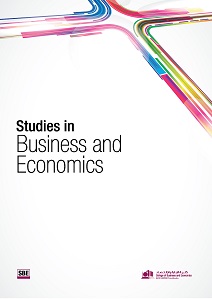Determination of Optimal Safety Stock Policies
Abstract
Setting safety stock policies are especially important in the management of retail and wholesale inventories, as well as stores, spare parts, supply items, and in certain areas of production planning. From a practical perspective, determining the optimal safety stock policy and the optimal service level requires specifying the demand distribution. This paper develops optimal safety stock policies under several commonly used statistical demand distributions; normal, exponential, andpoisson. In those situations where a manager has limited information on the shape of the demand distribution, Chebychev's Inequality Theorem is exploited to determine the optimal policies. The suggested computational approach enables the order quantity and the number of standard deviations that specifies the service level to be jointly determined by minimizing total relevant cost. A numerical example is also given to illustrate the computational process.
Metrics
Metrics Loading ...
##plugins.themes.bootstrap3.article.details##
Keywords
Safety Stock Policy
References
• Kobert, Norman, “Inventory Outlook: When to Use Safety Stock”, Purchasing, Vol. 90, No. 12, June 25, 1981.
• Krupp, James A.G., “Effective Safety Stock Planning”, Production & Inventory Management, 3rd quarter, 1982.
• Narasimhan, S.L., McLeavey D.W. , Billington , P., Production Planning and Inventory Control, Allyn & Bacon, 1994.
• Chase, R., Jacobs, R., and Aquilano, N., Operations Management For Competitive Advantage, McGraw-Hill/Erwin, 10th edition, 2005.
• Aucamp, D.C., “The Evaluation of Safety Stock”, Production & Inventory Management, Vol. 27, No. 2, 2nd quarter, 1986, pp. 126- 132.
• Silver, E., and Peterson, R., Decision Systems for Inventory Management and Production, John Wiley, New York, 2nd edition, 1991.
• Natrajam, R., “Inventory management“– The Big Picture”, Production and Inventory Management Journal, Vol. 32m No. 4, 4th quarter, 1981.
• Vargas, G.A. and Dean, R.G., “Buffering Against Multiple Uncertainty in Assembly Manufacturing,” ”Journal of Manufacturing and Operations Management, Vol. 12, No. 4, Winter 1980, pp. 306-334.
• Fildes, R. and Bead, C., “Forecasting Systems for Production and Inventory Control,” ”Journal of Operations and Production Management, Vol. 12, No. 5, 1992, pp.4 - 27.
• Freund, John, Elementary Business Statistics, Prentice Hall, 1964, p.177.
• Berry, S.E. and Lancaste, L.M., “Views of Production Practitioners on the Importance of Selected POM Topics: 1978 and 1989 Practitioners Compared” Production and Inventory Management Journal, Vol. 33, No. 2, 3rd quarter, 1992, pp.24-29.
• Sarkis, J., “Production and Inventory Control Issues in Advanced Marketing Systems.” Production and Inventory Management Journal, Vol. 32, No. 1, 1st Quarter 1991.
• Schragenheim, E., and Ronen, B., “Buffer Management: A Diagnostic Tool for Production Control,” ”Production and Inventory Management Journal, Vol. 32, No. 2, 2nd Quarter, 1991.
• Kahneman, D., Slovic, P., and Tversky, A., Judgement Under Uncertainty: Heuristics and Biases, Cambridge, England: Cambridge University Press, 1982.
• E. Frank Harrison, The Managerial Decision Making Process, Houghton Mifflin Company, 5th Edition, 1999.
• Max H. Bazerman, Judgment in Managerial Decision Making, John Wiley & Sons; 6th Edition, 2005.
• Gladstein, D.L., and Reilly, N.P. “Group Decision-Making Under Threat: the Tycoon Game,” ”Academy of Management Journal, 1985, 28, pp. 613-627.
• William J. Stevenson, Production Operations Management, McGraw-Hill, 1999.
• Krupp, James A.G., “Effective Safety Stock Planning”, Production & Inventory Management, 3rd quarter, 1982.
• Narasimhan, S.L., McLeavey D.W. , Billington , P., Production Planning and Inventory Control, Allyn & Bacon, 1994.
• Chase, R., Jacobs, R., and Aquilano, N., Operations Management For Competitive Advantage, McGraw-Hill/Erwin, 10th edition, 2005.
• Aucamp, D.C., “The Evaluation of Safety Stock”, Production & Inventory Management, Vol. 27, No. 2, 2nd quarter, 1986, pp. 126- 132.
• Silver, E., and Peterson, R., Decision Systems for Inventory Management and Production, John Wiley, New York, 2nd edition, 1991.
• Natrajam, R., “Inventory management“– The Big Picture”, Production and Inventory Management Journal, Vol. 32m No. 4, 4th quarter, 1981.
• Vargas, G.A. and Dean, R.G., “Buffering Against Multiple Uncertainty in Assembly Manufacturing,” ”Journal of Manufacturing and Operations Management, Vol. 12, No. 4, Winter 1980, pp. 306-334.
• Fildes, R. and Bead, C., “Forecasting Systems for Production and Inventory Control,” ”Journal of Operations and Production Management, Vol. 12, No. 5, 1992, pp.4 - 27.
• Freund, John, Elementary Business Statistics, Prentice Hall, 1964, p.177.
• Berry, S.E. and Lancaste, L.M., “Views of Production Practitioners on the Importance of Selected POM Topics: 1978 and 1989 Practitioners Compared” Production and Inventory Management Journal, Vol. 33, No. 2, 3rd quarter, 1992, pp.24-29.
• Sarkis, J., “Production and Inventory Control Issues in Advanced Marketing Systems.” Production and Inventory Management Journal, Vol. 32, No. 1, 1st Quarter 1991.
• Schragenheim, E., and Ronen, B., “Buffer Management: A Diagnostic Tool for Production Control,” ”Production and Inventory Management Journal, Vol. 32, No. 2, 2nd Quarter, 1991.
• Kahneman, D., Slovic, P., and Tversky, A., Judgement Under Uncertainty: Heuristics and Biases, Cambridge, England: Cambridge University Press, 1982.
• E. Frank Harrison, The Managerial Decision Making Process, Houghton Mifflin Company, 5th Edition, 1999.
• Max H. Bazerman, Judgment in Managerial Decision Making, John Wiley & Sons; 6th Edition, 2005.
• Gladstein, D.L., and Reilly, N.P. “Group Decision-Making Under Threat: the Tycoon Game,” ”Academy of Management Journal, 1985, 28, pp. 613-627.
• William J. Stevenson, Production Operations Management, McGraw-Hill, 1999.
How to Cite
Najdawi, Mohammad K., and Matthew J. Liberatore. 2006. “Determination of Optimal Safety Stock Policies”. Studies in Business and Economics (SBE) 12 (1). https://doi.org/10.29117/sbe.2006.0013.
Section
Articles

